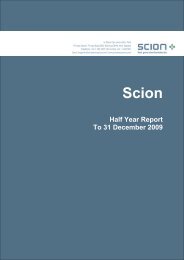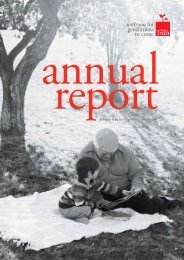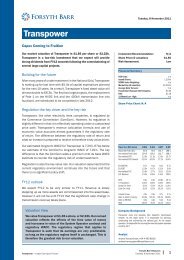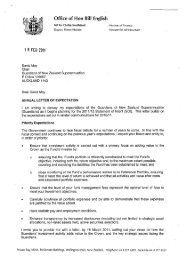apr-11.pdf (2.07 MB) - Crown Ownership Monitoring Unit
apr-11.pdf (2.07 MB) - Crown Ownership Monitoring Unit
apr-11.pdf (2.07 MB) - Crown Ownership Monitoring Unit
Create successful ePaper yourself
Turn your PDF publications into a flip-book with our unique Google optimized e-Paper software.
jurisdictions is fraught. There are a number of reasons to treat such results with caution.For example:• Differences in financial reporting standards, both across time and across countries,will impact calculated returns.• Costs of capital for the “average” New Zealand firm may be higher than for, say, a USfirm where risk-free rates may be lower and market risk premium is conventionally at alower level.• The calculations of ROIC are sourced from an external data provider wherecomparable adjustments may not have been made.All else being equal, two entities in different markets may display different ROICsdespite each generating the same EP relative to the appropriate WACC for theirjurisdiction. There is a full discussion on interpreting results in EY’s full report, which isavailable on COMU’s website.Within the commercial priority portfolio, results for individual companiesshow both positive and negative economic profits 12The <strong>Crown</strong>’s portfolio consists of companies with diverse characteristics that canimpact EP measures in different ways, affecting the interpretation of conclusionsaround performance.Generator/retailers – impact of revaluationsThe three generator/retailers represent more than half of the invested capital andover 90% of the asset revaluation gains registered in the 10 years to 2010/11. Withrevaluations, generator/retailer returns have been well in excess of WACC. However,peer returns are calculated excluding revaluation gains, and potentially on an assetbase that includes revalued assets. On this basis, the comparison between generator/retailers and peers is inconclusive.Other large entitiesThe SOE portfolio also includes major companies each with their own performancepattern.• EY reports that Transpower has produced on average a small, positive economicreturn. This is the expected outcome for a predominantly regulated naturalmonopoly. In the latter years, EY suggests Transpower has generated much largerEPs. This differs from the expected regulatory outcome and is primarily owing tovariances between EY’s methodology and the regulator’s approach. EY’s choice of aone-year risk-free rate in particular has a significant impact. International regulatorypractice is to use a longer-term risk-free rate (5 to 10 years) to reflect companies’actual financing arrangements.• Landcorp’s return, when including land revaluations, follows closely the pattern forland values over the past 10 years. If revaluations were to be excluded, Landcorp’sreturns would be negative, but steadier, not inconsistent with prevailing returns oninvestment in farming.12 A portfolio-wide analysis based on publicly available information, such as EY’s, is unlikely to provide the levelof precision of a bespoke company-level analysis with full access to company information. Care should betaken when considering EY’s results in relation to company-specific analyses.page | 35
















